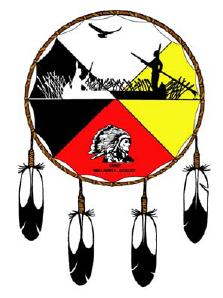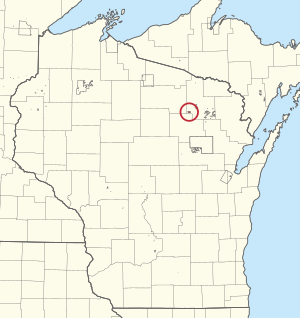Sokaogon Chippewa Community facts for kids
| Zaka'aaganing | |
|---|---|

Seal of the Sokaogon Chippewa Community
|
|
| Total population | |
| 1,377 (2010) | |
| Regions with significant populations | |
| Languages | |
| English, Ojibwe | |
| Related ethnic groups | |
| other Ojibwe people |
The Sokaogon Chippewa Community, also known as the Mole Lake Band of Lake Superior Chippewa, is a Native American tribe. They are officially recognized by the United States government. Many members of the tribe live on the Mole Lake Indian Reservation. This reservation is located in Forest County, Wisconsin, near the city of Crandon.
The Mole Lake Indian Reservation covers about 2.94 square miles (7.6 square kilometers). The tribe also owns other lands nearby. In total, the Sokaogon Chippewa Community manages about 4,904 acres (nearly 7.7 square miles or 20 square kilometers) of land. This land includes beautiful areas around Rice Lake, Bishop Lake, and Mole Lake.
In 2020, about 507 people lived on the reservation and its trust lands. Around 500 tribal members live on the reservation, and another 1,000 live in other places. The tribe is very active in harvesting wild rice. They gather this important food from the swampy areas on and near their reservation.
Contents
History of the Sokaogon Chippewa
The land where the Sokaogon Chippewa live has a long history.
Early Events and Tribal Rights
In 1806, a battle took place here between Chippewa and Sioux warriors. This event is known as the Battle of Mole Lake.
The Sokaogon Chippewa Community officially approved their own rules and laws on November 9, 1938. This was part of a larger plan called the Indian Reorganization Act. This act helped Native American tribes govern themselves.
A very important court decision happened in 1983. It was called the Lac Courte Oreilles v. Lester B. Voigt case, or simply the Voigt decision. This decision confirmed that the Sokaogon and other Chippewa tribes in northern Wisconsin could use their traditional rights. This meant they could hunt, fish, and gather resources, like wild rice, even on lands they didn't own.
The Historic Dinesen Log House
Mole Lake is home to one of Wisconsin's oldest log cabins. It is now called the Dinesen Log House. This special cabin was built in the late 1860s or early 1870s. It was added to the National Register of Historic Places in 2005. The cabin has been fully restored and opened to visitors in April 2010.
In the early 1870s, a Danish adventurer named Wilhelm Dinesen lived in the cabin. He became friends with the Mole Lake Chippewa people. He called his cabin "Frydenlund," which means "Grove of Joy." After more than a year of hunting, fishing, and exploring, he returned to Denmark. His daughter, Karen Blixen, grew up to be a famous author. She wrote the book Out of Africa, which later became a popular movie.
The Dinesen Log House is now a center for an annual event in August. Visitors can learn about history, listen to folk music, and enjoy traditional Native American food. There are also demonstrations of Native American arts and crafts, like beadwork and basket making. You can even try wild rice soup and learn some Ojibwe language!
Protecting Their Land: The Exxon Mine Story
In the late 1960s, a company called Exxon found a large deposit of zinc and copper near Mole Lake. This was one of the richest deposits of its kind in North America.
Concerns About the Mine
In 1976, Exxon announced plans to start mining. This mine would have been very close to the lands of four Native American communities, including the Sokaogon Chippewa's wild rice fields. The idea of the mine caused a big disagreement that lasted for 30 years.
The local tribes, including the Sokaogon Chippewa, the Potawatomi, the Menominee, and the Stockbridge Munsee, were very worried. They believed the mine would harm the environment and their way of life. Any pollution of the water would threaten their survival. The Sokaogon Chippewa were especially concerned about their wild rice fields. Other tribes worried about the large amount of wastewater the mine would release into nearby rivers.
Tribes Buy the Mine to Protect the Environment
To protect their lands and resources, the Sokaogon Chippewa Community worked with the neighboring Forest County Potawatomi Community. Together, they bought the nearby Crandon mine for $16.5 million. Their goal was to stop the mine from ever opening.
The tribes argued that opening the zinc and copper mine would damage the environment. It would also put their important wild rice fields at risk. Now, the land is controlled by the two tribes. There are no plans for any mining in the future. This shows how important it is to protect natural resources and traditional ways of life.


